

The Research Behind Choice and Inquiry-Based Education. Updated: I’ve updated this post and page since publishing my most recent book about student choice.
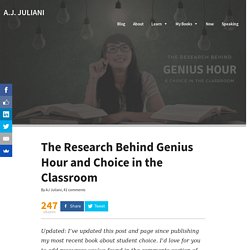
I’d love for you to add resources you’ve found in the comments section of this post so I can add them to the list! Since experimenting with “Genius Hour and 20% Time” in my class a few years ago, I’ve been fascinated by the research and history of this practice in education and the business world. This has led me down a long road to eventually writing Inquiry & Innovation in the Classroom (published by Routledge) on inquiry-driven education and choice-based learning experiences. During that time I’ve had hundreds of conversations with fellow teachers practicing choice-based and inquiry-driven learning in some way shape or form (Genius Hour, 20% Time, Passion Projects, Choose2Matter etc). Today I want to shed some light on the research behind choice, and more broadly, inquiry-driven education. I’m breaking the post down into four sections. Crafting Questions That Drive Projects.
Which comes first, the driving question or the learning goals?
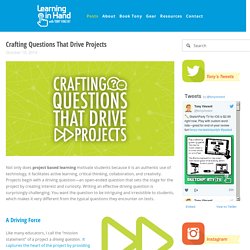
I think it depends. The most successful projects feed off of students’ passions. Don’t be afraid to tap into them. Take what they are interested in and find a way to connect that interest to learning standards. In my first year of teaching, my fifth graders were obsessed with SpongeBob Squarepants. What adventures would SpongeBob have during the Great Depression? So, to develop a driving question, you can use students' interest as a starting point and then creatively connect learning standards. Some of the learning aims my school had for students in math were working with decimals and graphing data. So, you can start with a topic or you start with learning standards to develop a driving question. My experience in getting started with Genius Hour. Since my return from the #STACCE13 tour, myself and a collegue (@rissL) had the ambition to trial Genius Hour with our students (You can read about her introduction to Genius Hour with her students here).
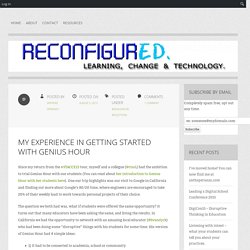
One our trip highlights was our visit to Google in California and finding out more about Google’s 80/20 time, where engineers are encouraged to take 20% of their weekly load to work towards personal projects of their choice. The question we both had was, what if students were offered the same opportunity? It turns out that many educators have been asking the same, and living the results.
In California we had the opportunity to network with an amazing local educator (@bvandyck) who had been doing some “disruptive” things with his students for some time. His version of Genius Hour had 4 simple ideas: At the ISTE13 conference, we caught further murmurings of terms like Genius Hour and 20 Time. Starting out.
Gallit Zvi: Genius Hour ISTE Snapshot. On June 29, 2015 I had the pleasure of presenting at ISTE 2015.
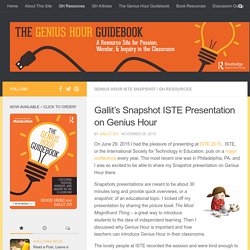
ISTE, or the International Society for Technology in Education, puts on a major conference every year. This most recent one was in Philadelphia, PA, and I was so excited to be able to share my Snapshot presentation on Genius Hour there. Snapshots presentations are meant to be about 30 minutes long and provide quick overviews, or a snapshot, of an educational topic. I kicked off my presentation by sharing the picture book The Most Magnificent Thing – a great way to introduce students to the idea of independent learning. 5/6 Genius Hour @ St Mark's. Our Genius In Action. This is the place where we will share our learning journey with you.

Hint:Any text in red is a link to another page, website or document. Our focus for the year will be on the successful integration of technology into our learning. Safety and etiquette are important factors to consider when integrating technology into our classroom. Please read Using Technology and have some discussion with your genius regarding safety and manners. Please remember you are NOT required to purchase a device. "Technology", "ICT", "IWB", "Web 2.0", "Connect", "VR" The terminology associated with technology can be confusing.
Please ask me to clarify if you hear or read something that you don't understand. Genius Hour. Genius Hour / 20% Time. Genius Hour / 20% Time. Genius Hour Creativity Rubric. Genius Hour - Where Passions Come Alive - Genius Hour. What is Genius Hour? - Genius Hour. What is Genius Hour?
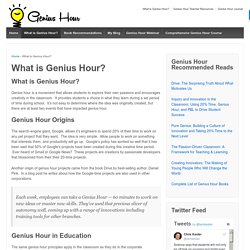
Genius hour is a movement that allows students to explore their own passions and encourages creativity in the classroom. It provides students a choice in what they learn during a set period of time during school. It’s not easy to determine where the idea was originally created, but there are at least two events that have impacted genius hour.
Genius Hour Origins The search-engine giant, Google, allows it’s engineers to spend 20% of their time to work on any pet project that they want. Another origin of genius hour projects came from the book Drive by best-selling author, Daniel Pink. Each week, employees can take a Genius Hour — 60 minutes to work on new ideas or master new skills. Genius Hour in Education The same genius hour principles apply in the classroom as they do in the corporate environment. By Angela Maiers and Amy Sandoval. Many teachers are raving about the autonomy that students are finding in their classes, including myself.